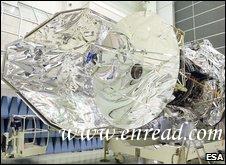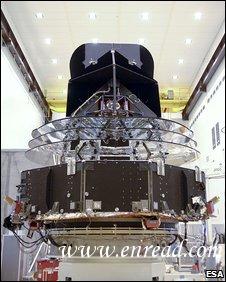| ||||||||||||||||||||||||||||||||||||||||||||||||||||||||||||||||||||||||||||||||||||||||||||||||||||||||||||||||||||||||||||||||||||||||
|
Europe's Herschel and Planck telescopes have blasted into space on an Ariane 5 rocket from Kourou in French Guiana. 欧盟的Herschel和Planck天文望远镜已经搭载Ariane 5在法属圭亚那的库鲁地区升空。 The satellites are being sent into orbit to gather fundamental new insights into the nature of the cosmos1. The Ariane thundered clear of the launch pad at 1312 GMT (1412 BST) - its flight lasting2 just under half an hour. Mission controllers in Germany made contact with the telescopes over the Indian Ocean once they had separated from the rocket's upper-stage. The acquisition(获得,所获之物) of the signals, relayed through ground stations in Australia, will have been a moment of huge relief for everyone connected with the two observatory3 projects. Their combined programme cost is 1.9bn euros (£1.7bn; $2.5bn), which made Herschel and Planck the highest value payload(有效负载) the European Space Agency's (Esa) science division had ever put on a single rocket. "The launch today is just one step in a long chain of decisions and a fantastic amount of work by thousands of scientists and engineers," said agency director-general Jean-Jacques Dordain. "All these scientists and engineers have worked together with just one objective, which is to discover the unknown and to make the technologies that are necessary to make this scientific progress." The ascent4 through the Earth's atmosphere was just the first stage in what will be a long journey for the astronomical5(天文学的) satellites. They will spend the next two-to-three months making their way out to observation positions some 1.5 million km from Earth on its "night side". The long cruise(巡航,巡弋) will allow engineers to check out sub-systems and commission the telescopes' instruments. One of the first things controllers have to do is to get a precise description of the telescopes' orbits. The Ariane is an excellent rocket but the satellites will almost certainly need some correction to their flight paths to be sure of making the proper transition to deep space. To save fuel, the controllers would like to make these correction manoeuvres as early as possible, perhaps on Friday. Birth of stars Herschel is the largest telescope anyone has put in space. Its 3.5m-diameter primary mirror is one-and-a-half-times the size of Hubble's main reflector. Such size would ordinarily incur6(招致,蒙受) a huge weight penalty but the Herschel mirror has been kept to just 350kg by constructing it from silicon7 carbide, a novel ceramic8 material. The telescope will be sensitive to far-infrared9 and sub-millimetre (radio) wavelengths10 of light, allowing it to peer through clouds of dust and gas to see stars at the moment they are born. This infrared capability11 will also enable Herschel to look deep into space, to gaze at those galaxies12 that thrived when the Universe was roughly a half to a fifth of its present age. It is a period in cosmic history when it is thought star formation was at its most prolific13. "Herschel is going to help us understand much, much better how stars form right now and how they have been forming throughout billions of years of cosmic history; and therefore, indirectly14, it's going to help us understand how our own Sun and our own Solar System formed," Dr Göran Pilbratt, Esa's Herschel project scientist, told BBC News. The spacecraft carries an enormous flask15(细颈瓶,烧瓶) of "superfluid" helium to chill its instruments and detectors16 close to minus 273C (or "absolute zero", the point beyond which no further cooling is possible). "We are observing at long wavelengths where all warm objects glow, so we need to cool the telescope and the instruments as much as possible, otherwise the weak signals we are trying to detect from the sky will be totally swamped by radiation emitted by the telescope itself," said Professor Matt Griffin from Herschel's Spire17 instrument team. 点击  收听单词发音 收听单词发音
|
||||||||||||||||||||||||||||||||||||||||||||||||||||||||||||||||||||||||||||||||||||||||||||||||||||||||||||||||||||||||||||||||||||||||
- 发表评论
-
- 最新评论 进入详细评论页>>





